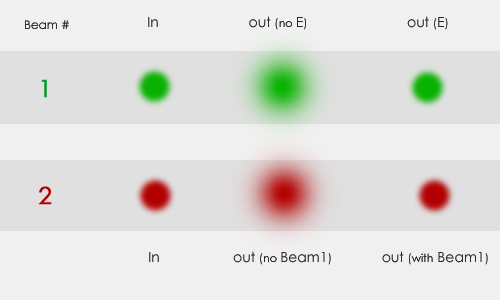Optical Waveguide








Light beam self-focusing and the formation of optical spatial solitons in photorefractive materials can be used to optically induce a refractive index profile, which would then guide another beam. An example of an experimental arrangement illustrating this effect is shown below. A 2D Gaussian-like collimated beam (Beam 1) from, for example, a 780-nm laser diode, is incident on the photorefractive sample, and forms soliton. Another Gaussian-like beam (Beam 2) from, for example, a 980-nm laser diode is used as a probe beam, following the same path taken by the 780-nm soliton-forming beam. Behind the sample, a CCD camera (with imaging lens) is used to monitor the beam profiles.

The beam profile of the 780-nm beam at the input face of the sample is shown below (Beam 1, In). Without the applied field, the beam profile measured in the output plane of the sample is broadened due to diffraction (Beam 1, out(no E)). After an electric field was applied, self-trapping of the 2D y-polarized beam was realized (Beam 1, out(E)). Once the soliton was formed, the 780-nm soliton beam was replaced with a 980-nm probe beam (beam 2, In) to test the optically-induced waveguide. Without the waveguide, the probe beam diffracted normally (Beam 2, out(no Beam 1)). With the soliton waveguide, however, the probe was guided very well as its size at the output of the sample was reduced significantly (Beam 2, out(with Beam 1)). Under the same experimental conditions, the 980-nm probe beam itself did not show appreciable self-focusing, since the PR organic glass utilized in this experiment did not have sensitivity at this wavelength (i.e. illumination with a 980-nm beam did not result in charge carrier generation). This confirms that the observed guiding is due to the refractive index profile created by the 780-nm beam.M. Asaro et al., Opt. Lett. 30, 519 (2005)

Optically-induced guiding can be utilized in a number of applications such as optical couplers, switches, logic gates, nonlinear frequency converters, optical parametric oscillators, and many others.